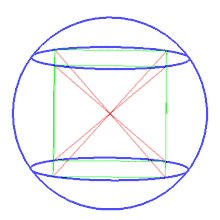Circumscribed sphere
In geometry, a circumscribed sphere of a polyhedron is a sphere that contains the polyhedron and touches each of the polyhedron's vertices.[1] The word circumsphere is sometimes used to mean the same thing.[2] As in the case of two-dimensional circumscribed circles, the radius of a sphere circumscribed around a polyhedron P is called the circumradius of P,[3] and the center point of this sphere is called the circumcenter of P.[4]

Existence and optimality
When it exists, a circumscribed sphere need not be the smallest sphere containing the polyhedron; for instance, the tetrahedron formed by a vertex of a cube and its three neighbors has the same circumsphere as the cube itself, but can be contained within a smaller sphere having the three neighboring vertices on its equator. However, the smallest sphere containing a given polyhedron is always the circumsphere of the convex hull of a subset of the vertices of the polyhedron.[5]
In De solidorum elementis (circa 1630), René Descartes observed that, for a polyhedron with a circumscribed sphere, all faces have circumscribed circles, the circles where the plane of the face meets the circumscribed sphere. Descartes suggested that this necessary condition for the existence of a circumscribed sphere is sufficient, but it is not true: some bipyramids, for instance, can have circumscribed circles for their faces (all of which are triangles) but still have no circumscribed sphere for the whole polyhedron. However, whenever a simple polyhedron has a circumscribed circle for each of its faces, it also has a circumscribed sphere.[6]
Related concepts
The circumscribed sphere is the three-dimensional analogue of the circumscribed circle. All regular polyhedra have circumscribed spheres, but most irregular polyhedra do not have one, since in general not all vertices lie on a common sphere. The circumscribed sphere (when it exists) is an example of a bounding sphere, a sphere that contains a given shape. It is possible to define the smallest bounding sphere for any polyhedron, and compute it in linear time.[5]
Other spheres defined for some but not all polyhedra include a midsphere, a sphere tangent to all edges of a polyhedron, and an inscribed sphere, a sphere tangent to all faces of a polyhedron. In the regular polyhedra, the inscribed sphere, midsphere, and circumscribed sphere all exist and are concentric.[7]
When the circumscribed sphere is the set of infinite limiting points of hyperbolic space, a polyhedron that it circumscribes is known as an ideal polyhedron.
References
- James, R. C. (1992), The Mathematics Dictionary, Springer, p. 62, ISBN 9780412990410.
- Popko, Edward S. (2012), Divided Spheres: Geodesics and the Orderly Subdivision of the Sphere, CRC Press, p. 144, ISBN 9781466504295.
- Smith, James T. (2011), Methods of Geometry, John Wiley & Sons, p. 419, ISBN 9781118031032.
- Altshiller-Court, Nathan (1964), Modern pure solid geometry (2nd ed.), Chelsea Pub. Co., p. 57.
- Fischer, Kaspar; Gärtner, Bernd; Kutz, Martin (2003), "Fast smallest-enclosing-ball computation in high dimensions", Algorithms - ESA 2003: 11th Annual European Symposium, Budapest, Hungary, September 16-19, 2003, Proceedings (PDF), Lecture Notes in Computer Science, 2832, Springer, pp. 630–641, doi:10.1007/978-3-540-39658-1_57.
- Federico, Pasquale Joseph (1982), Descartes on Polyhedra: A Study of the "De solidorum elementis", Sources in the History of Mathematics and Physical Sciences, 4, Springer, pp. 52–53
- Coxeter, H. S. M. (1973), "2.1 Regular polyhedra; 2.2 Reciprocation", Regular Polytopes (3rd ed.), Dover, pp. 16–17, ISBN 0-486-61480-8.
External links
| Wikimedia Commons has media related to Circumscribed spheres. |